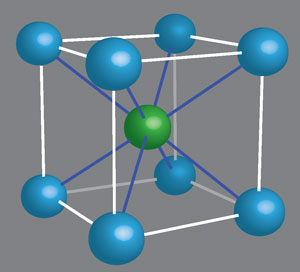|
NEWS NOTES
Are we square?
 source: Matvis, image by AGI |
| Iron crystals in Earth's inner core probably have a "body-centered cube" shape. Although apparently symmetrical, at very high pressures and temperatures, seismic waves actually move faster through the iron cubes in one direction than in others. |
Among the many mysteries buried in Earth’s core, one long-standing question is this: Why do seismic waves travel 3 to 4 percent faster through the inner core in one direction — the one parallel to Earth’s axis, or pole to pole — than in the direction parallel to the equator?
One proposed explanation for that odd offset could be that the iron crystals packed into the inner core may themselves be asymmetrical. But new evidence now suggests that iron crystals in the core may have a symmetrical shape after all — that of a perfect cube.
The original assumption — that iron crystals in the core have a “close-packed hexagonal” shape — seemed reasonable, since iron crystals can take that shape at intensely high pressure. Plus, that complicated hexagonal structure might also be responsible for the difference in wave speeds.
But recent experiments that accurately recreated both the pressures and temperatures of the inner core found a problem: At very high temperatures, seismic waves actually move through those hexagonal crystals at the same speed in all directions, says Anatoly Belonoshko, a materials physicist at the Royal Institute of Technology in Stockholm, Sweden. Therefore, some other structure may be behind the observed difference in wave speeds traveling through Earth, he says.
“Most people are used to the idea that hexagonal iron is stable in Earth’s inner core,” Belonoshko says. In fact, scientists have focused on that hexagonal shape for 40 years. But “this paradigm is beginning to change,” he says. “People thought they were studying the material in Earth’s core, but now it appears that what they studied might not exist anywhere but in the laboratory.”
Belonoshko and his colleagues suggest a different scenario Feb. 8 in Science. They simulated the movement of sound waves through iron crystals in a different, perfectly symmetrical shape, called body-centered cubic. Studying waves traveling through three different iron samples, all in the cubic shape, they recreated the inner core’s intense heat and pressure and observed how quickly the waves passed through the crystals in three different orientations.
What they found, Belonoshko says, was that under the intense core-like conditions the sound waves moved 12 percent more quickly in one direction through the cubes than in the others. Given that not all of the crystals in the inner core would be arranged facing the same way, the average difference in wave speeds traveling in two different directions could certainly match the observed 3 to 4 percent, he says.
Unlike the hexagonal iron hypothesis, this scenario matches the observed data, Belonoshko says. “The next step would be to understand the mechanism” — why the crystals are oriented the way they are, he says. But if his scenario is correct, its implications are significant. “The amount of heat that is preserved in Earth depends on the particular phase [of iron],” he says. “It’s like a battery — how much heat capacity it has depends on its composition and structure.” The hexagonal and cubic phases of iron have different heat capacities, and even at the same core temperatures, they might hang on to different amounts of heat. As a result, he says, if the structure of the core is different than previously thought, scientists may need to reconsider how quickly Earth has cooled.
This idea is a “well-reasoned alternative” to the existing ideas that were starting to appear less convincing, says J. Michael Brown, a mineral physicist at the University of Washington in Seattle. For one thing, for the hexagonal structure to work, the crystals would all have to have been similarly aligned — which seems pretty unlikely, Brown says. “The larger degree of [wave speed difference] for this [cubic] form of iron has the nice characteristic of allowing one to have less than perfect alignment, which seems more plausible.”
With the cubic hypothesis as another starting point, there are plenty of new questions to delve into about the core and the formation of Earth, Brown says. Inextricably tied to the planet’s magnetic field, the inner core “contains important information about the history of Earth,” he says. “It really begs the question of how did the inner core form, and what does this variation of alignment tell us about that history.”

 Subscribe
Subscribe


